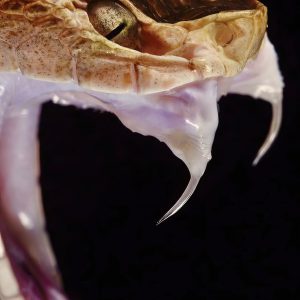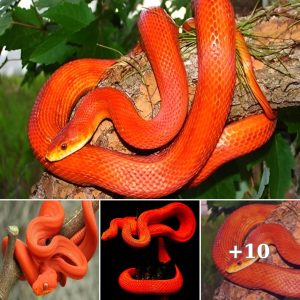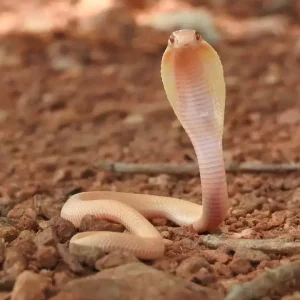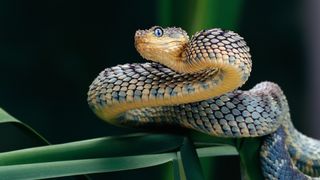
Researchers looked at female snakes from the viper family and others to describe the clitoris, known as a hemiclitoris in snakes, which had never been done before. (Image credit: David A. Northcott via Getty)
Megan Folwell stood over a female Australian death adder (Acanthophis antarcticus), armed with a scalpel. The snake was dead, donated by a venom supply company. Very carefully, Folwell, an evolutionary biologist at the University of Adelaide in Australia, made an incision near the animal’s tail. She was about to go where no scientists had gone before.
“I went into it not knowing what I was going to see,” Folwell told Live Science.
Until now, no one had taken the time to look for and describe a snake’s clitoris. With the exception of birds, clitorises are found in every vertebrate lineage, including snakes’ closest cousins, lizards. But when Folwell went looking for literature about the organ in serpents, she came up empty-handed. “It just didn’t make sense to me,” she said. “I knew there had to be something going on.”
So she and her team decided to investigate. Their results, published Dec. 14 in the journal Proceedings of the Royal Society B, describe the structure of the forked “hemiclitoris” in snakes for the first time.
The sun is Earth’s closest star, yet its beauty is too intense to appreciate with the naked eye. Here are some of the most stunning solar images that our satellites and telescopes have captured.
In contrast, male snake genitalia have been well documented across a variety of species. Male snakes have a structure called a hemipenis, essentially a two-pronged penis tucked under the base of the tail (and often held inside the body until mating). Much scientific ink has been spilled over the past 200 years describing differences between hemipenes, which range in size and shape from tiny twin toothpicks to huge, elaborate organs with “a lot of spines on them and whatnot,” said Richard Shine, an evolutionary biologist at Macquarie University in Australia who was not involved in the study.
Despite more than two centuries’ worth of data on hemipenes, however, nobody had described an equivalent structure in female snakes. The lack of evidence caused some scientists to speculate that snake hemiclitorises might not exist at all — or that, if they did, they had been reduced to a stunted evolutionary remnant.
A lack of research around female anatomy is a troubling scientific trend. Even in humans, surprisingly little is known about the clitoris. The full structure of the organ, which includes not only the little nub at the top of the labia but also two large internal bulbs full of nerve endings, wasn’t discovered until the mid-1840s. Even then, it remained relatively obscure to the medical establishment until Australian urologist Helen O’Connell’s work in 2005, which showed that typical textbook depictions of the clitoris were riddled with inaccuracies. In fact, just last month, scientists counted all 10,000 nerve fibers in the human clitoris for the first time.
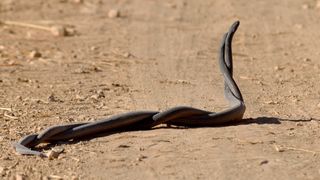
Data about female reproductive anatomy and behavior in nonhuman animals are even more scarce. A November analysis published in the journal Nature found that between 1970 and 2021, more than seven times as many papers were published about sperm competition in animals compared with female mate selection. A 2014 perspectives article published in the journal PLOS Biology found that about 50% of all studies of animal genitalia published between 1989 and 2013 focused exclusively on males, while 10% focused only on females.
“If genetal evolution research only investigates the male parts, it gives a very lopsided understanding of nature,” Malin Ah-King, an evolutionary biologist and gender researcher at Stockholm University in Sweden who was not involved in the new research, told Live Science. This bias has led scientists to overlook certain important aspects of female reproduction — such as the existence of entire organs.
Thanks to Folwell’s efforts, we now know that hemiclitorises exist in at least nine snake species. Folwell carefully dissected preserved specimens from four snake families (Elapidae, Pythonidae, Colubridae and Viperidae) and ran them through a CT (computed tomography) scan, noting the size and shape of each hemiclitoris. She found that they varied as much as hemipenes.
“Seeing the nerve structure, it was really exciting,” said Folwell, the study’s first author. And in other scientists’ defense, she said, the tissue that makes up snakes’ hemiclitorises is quite delicate (even though, in some cases, the organ was fairly large).
Shine described the new research as “an excellent piece of work.” “It certainly convinces me that there is a structure there,” he told Live Science.
For Folwell and her team, this study is merely the start of this research. She hopes that future work will uncover a fuller picture of the hemiclitoris’s evolutionary history and how it fits into snake mating behavior. “We’re really very excited about all of this,” she said.

